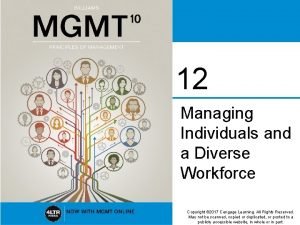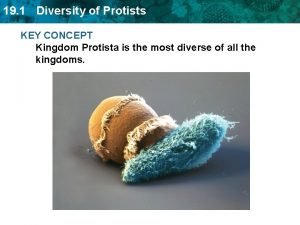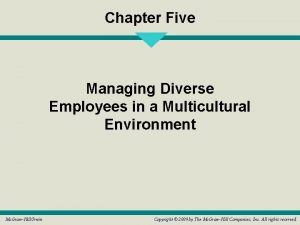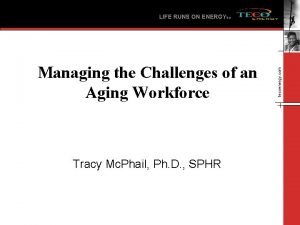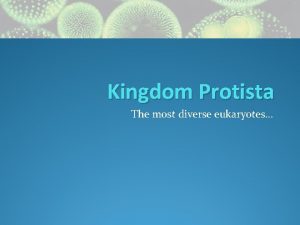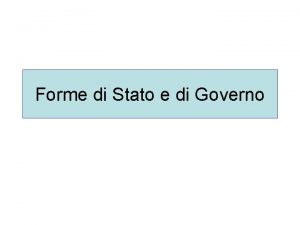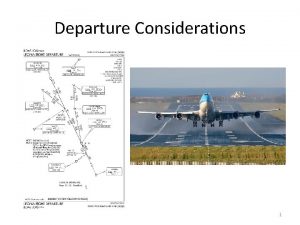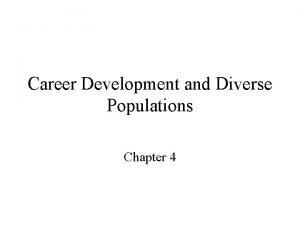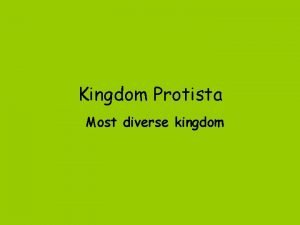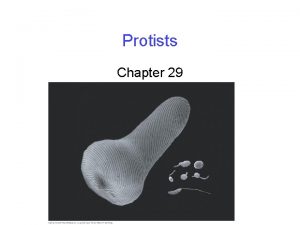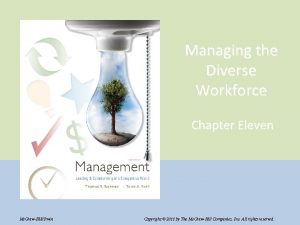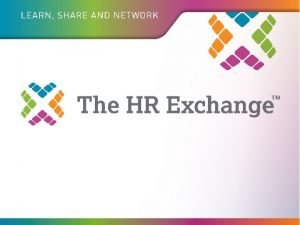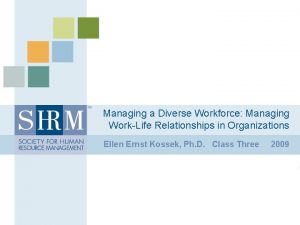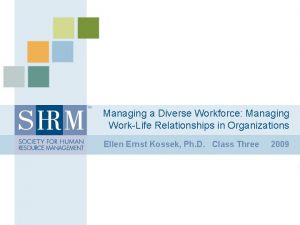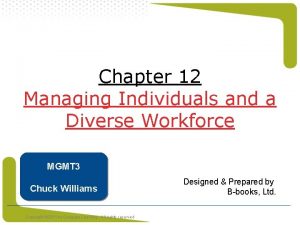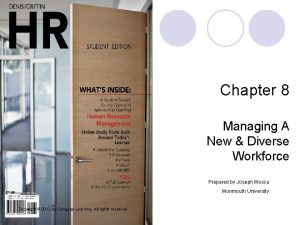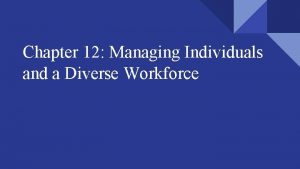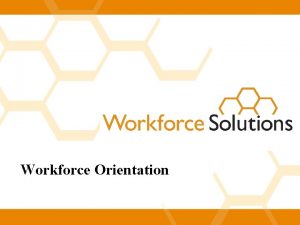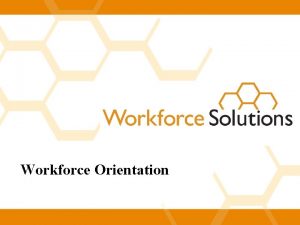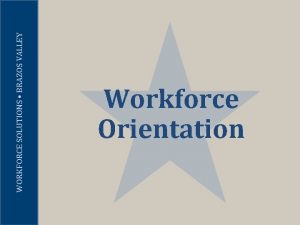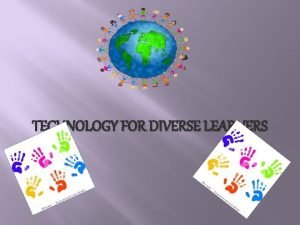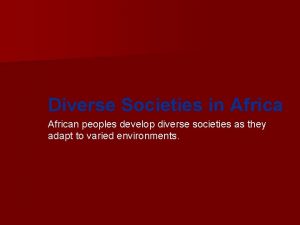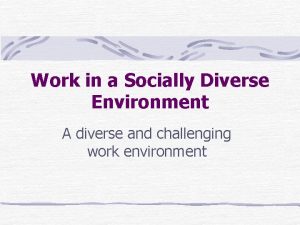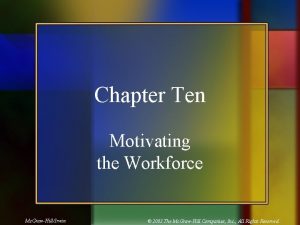Chapter 17 Managing a Diverse Workforce Mc GrawHillIrwin


























- Slides: 26

Chapter 17 Managing a Diverse Workforce Mc. Graw-Hill/Irwin Copyright © 2011 by The Mc. Graw-Hill Companies, Inc. All rights reserved.

Ch. 17 Key Learning Objectives Ø Knowing in what ways the workforce of the United States is diverse, and evaluating how it might change in the future Ø Understanding where women and persons of color work, how much they are paid, and the roles they play as managers and business owners Ø Identifying the role government plays in securing equal employment opportunity for historically disadvantaged groups, and debating whether or not affirmative action is an effective strategy for promoting equal opportunity Ø Assessing the ways diversity confers a competitive advantage Ø Formulating how companies can best manage workforce diversity, making the workplace welcoming, fair, and accommodating to all employees Ø Understanding what policies and practices are most effective in helping today’s employees manage the complex, multiple demands of work and family obligations 17 -2

The Changing Face of the Workforce Ø Diversity – Refers to variation in the important human characteristics that distinguish people from one another § Primary dimensions: age, ethnicity, gender, mental or physical abilities, race, sexual orientation § Secondary dimensions: such characteristics as communication style, family status and first language Ø Workforce diversity: diversity among employees of a business or organization § Represents both a challenge and an opportunity for businesses 17 -3

The Changing Face of the Workforce Ø Today, the U. S. workforce is as diverse as it ever has been, and it is becoming even more so. Consider the following workforce diversity trends: § § § More women are working than ever before Immigration has profoundly reshaped the workplace Ethnic and racial diversity is increasing The workforce will continue to get older Millennials are entering the workforce 17 -4

Gender and Race in the Workplace Ø Following World War II, the proportion of women working outside the home has risen dramatically § Most dramatic increases have been married women, mothers of young children, and middle-class women § Increase in professional, technical and service jobs produced “demand-side” pull for women into the labor force Ø Labor force rates for minorities have always been high § Change is that wider range of jobs are available to minorities as discrimination barriers have fallen 17 -5

Figure 17. 1 Proportion of Women and Men in the Labor Force 1950 -2007 17 -6

The Gender and Racial Pay Gap Ø Pay gap – Women and persons of color on average receive lower pay than white men do § Gap has narrowed over the past 3 decades § Still, in 2004 black men and white women earned slightly more than 75% white men’s pay, for black women this figure was 69% 17 -7

Figure 17. 2 The Gender and Race Pay Gap 1990 -2007 17 -8

The Gender Pay Gap Ø Reasons for pay gap § Some believe is evidence of sexual discrimination § Some believe is women’s choices in pursuing lower paying jobs or slower advancement § Others believe occupational segregation is occurring • Inequitable concentration of a group in certain job categories § Women have made great strides in entering professional occupations, however “pink collar ghetto” still exists • Examples include preschool teachers and receptionists 17 -9

Women in Management Ø Women have broken into management ranks § Tends to be, however, in occupations where women are numerous like education and health care Ø Only a very few women or persons of color have achieved highest positions in corporate America § Although women and minorities are as competent as white men in managing people and organizations, they rarely attain the highest positions in corporations 17 -10

The Glass Ceiling Ø Invisible barrier that exists in reaching these higher levels has been named the glass ceiling Ø Reasons for the glass ceiling: § Glass walls – fewer opportunities to move into positions that lead to the top; many women and minorities start in staff rather than line positions § Recruiters fill positions by word of mouth and is still “old boys network” Ø Recent advances show some cracking of the ceiling 17 -11

Figure 17. 3 Extent of Diversity in Selected Management Occupations 17 -12

Women and Minority Business Ownership Ø Some women and minorities have chosen to avoid the glass ceiling by opening up their own businesses Ø 2009, 40% of over 10 million U. S. businesses were owned or controlled by women § Although most female-headed firms are small, collectively they employed over 13 million people in the United States and generate $1. 9 trillion in sales 17 -13

Women and Minority Business Ownership Ø According to the Small Business Administration, there were around 4. 1 million minority-owned businesses in the United States in 2002 § Hispanic-owned businesses were the most numerous, followed by African-American and Asianowned businesses § Nearly half of Hispanic business owners and more than two-thirds of Asian business owners were immigrants 17 -14

Equal Employment Opportunity Ø Government involvement in securing equal employment for all began in the 1960 s on a large scale Ø Is defined as discrimination based on race, color, religion, sex, national origin, physical or mental disability, or age § In U. S. is prohibited in all employment practices § Government contractors must have written affirmative action plans detailing how they are working positively to overcome past and present effects of discrimination in their workforce § Women and men must receive equal pay for performing equal work, and employers may not discriminate on the basis of pregnancy 17 -15

Figure 17. 4 Major Federal Laws and Executive Orders Prohibiting Job Discrimination 17 -16

Affirmative Action Ø Since mid-1960 s, government contractors been required to have affirmative action plans § Purpose to reduce job discrimination by encouraging companies to take positive steps to overcome past discriminatory employment practices Ø Affirmative action became increasingly controversial in the 1990 s and 2000 s § Some states passed laws banning it in public hiring § Opponents cite possibility of reverse discrimination Ø In 1995, the Supreme Court ruled that affirmative action laws were legal but only if they were temporary and flexible § This approach was upheld in 2003 17 -17

Sexual Harassment Ø Occurs at work when: § Any employee, woman or man, experiences repeated, unwanted sexual attention or § When on‑the‑job conditions are hostile or threatening in a sexual way § It includes both physical conduct—for example, suggestive touching—as well as verbal harassment, such as sexual innuendoes, jokes, or propositions § It can also occur if a company’s work climate is blatantly and offensively sexual or intimidating to employees § Is illegal and U. S. EEOC is empowered to sue on behalf of victims § E. U. recognized sexual harassment as a form of gender discrimination in 2002, required its member states to bring their laws into compliance by 2005 17 -18

Racial Harassment Ø Is also illegal, under Title VII of the Civil Rights Act Ø Under EEOC guidelines, ethnic slurs, derogatory comments, or other verbal or physical harassment based on race are against the law, if they create an intimidating, hostile, or offensive working environment or interfere with an individual's work performance 17 -19

Preventing Sexual and Racial Harassment Ø In 1998, the Supreme Court ruled that companies could deflect lawsuits by taking two steps: § Develop a zero-tolerance policy on harassment and communicate it clearly to employees § Establish a complaint procedure—including ways to report incidents without retaliation—and act quickly to resolve any problems § In addition, stated that companies that took such steps would be protected from suits by employees who claimed harassment but had failed to use the complaint procedure 17 -20

Diversity Practices Ø Well run companies go beyond required legal actions to welcome employees of all backgrounds Ø Actions taken by companies to manage diversity effectively: § § They articulate a clear diversity mission, set objectives, and hold managers accountable They spread a wide net in recruitment, to find the most diverse possible pool of qualified candidates They identify promising women and persons of color, and provide them with mentors and other kinds of support They set up diversity councils to monitor the company’s goals and progress toward them 17 -21

Strategic Advantages of Managing Diversity Effectively Ø Companies that promote equal employment opportunity generally do better at attracting and retaining workers from all backgrounds Ø Businesses with employees from varied backgrounds can often more effectively serve customers who are themselves diverse Ø The global marketplace demands a workforce with language skills, cultural sensitivity, and awareness of national and other differences across markets Ø Companies with effective diversity programs can avoid costly lawsuits and damage to their corporate reputations from charges of discrimination or cultural insensitivity 17 -22

Work/Family Balance Issues Ø Changing demographics of increasing number of dual income families have caused them to adopt wide strategies for combining full and part-time work with the care of children, elderly relatives, and other dependents Ø Helping “make it work” for employees trying to balance the complex, multiple demands of work and family life has became a major business challenge 17 -23

Work/Family Balance Issues Ø Types of programs companies are offering: § § § Child Care Elder Care Parental and family leave Work flexibility Benefits to non-traditional families Ø Some employees have been reluctant to take advantage of work flexibility options, for fear of being labeled “mommy track” or “daddy track” § A shift in corporate cultures is needed to truly become a “family friendly” company where men and women are fully supported in their efforts to balance work and family responsibilities, example provided on next slide 17 -24

Exhibit 17. C A Family-Friendly Chief Executive Excerpts Ø Working Mother magazine singled out Steve Sanger, CEO of General Mills, for his commitment to building a family-friendly company. Ø General Mills has been an innovator in integrating family considerations into its operations. Some of its programs include: § An on-site infant care center § Flexible work arrangements § On-site health care services, including mammograms for busy working mothers § Emergency child care for parents whose regular arrangements fall through § Exercise classes offered at the company’s health and fitness center. Ø In explaining the business benefits of General Mills’ family programs, Sanger commented, “You know what’s really expensive? Turnover. If we’ve invested in recruiting and developing good people, then we want them to stay. ” 17 -25

Exhibit 17. D Domestic Partner Benefits Ø Many corporations in the United States have begun to acknowledge differences in employee sexual orientation and gender identity. Gay, lesbian, bisexual, and transgender employees have become a vocal minority, winning important victories in the workplace. Ø By 2008, 286 of the Fortune 500 companies provided health benefits to domestic partners and same-sex spouses, according to the Human Rights Campaign Foundation; the proportion doing so had doubled in the previous 5 years. Ø Lotus Development was the first major employer to offer spousal benefits to same‑sex partners; it was followed by many others, including AT&T, Chase Manhattan, Microsoft, United Airlines, and the Big Three automakers. Ø Other steps companies have taken to support their homosexual employees have included written anti-discrimination policies, management training on sexual diversity issues, and visible gay and lesbian advertising. 17 -26
 Managing individuals and a diverse workforce
Managing individuals and a diverse workforce Diversity of protists
Diversity of protists Managing diverse employees in a multicultural environment
Managing diverse employees in a multicultural environment Managing the aging workforce challenges and solutions
Managing the aging workforce challenges and solutions Chapter 16 section 1 russia and the western republics
Chapter 16 section 1 russia and the western republics Chapter 2 workforce safety and wellness
Chapter 2 workforce safety and wellness Most diverse group of organisms
Most diverse group of organisms Fenomenul de schimbare a directiei de propagare a luminii
Fenomenul de schimbare a directiei de propagare a luminii Categories of protists
Categories of protists These are sites that focus on short updates from the users
These are sites that focus on short updates from the users Presidente della repubblica
Presidente della repubblica Diverse ion effect
Diverse ion effect Algae uses
Algae uses African iron age
African iron age Odp vs sid
Odp vs sid Career development of diverse populations
Career development of diverse populations Art is diverse
Art is diverse Altezza del parallelogramma
Altezza del parallelogramma We live in a diverse world
We live in a diverse world Diverse comparative and superlative forms
Diverse comparative and superlative forms It is a diverse group of hydrophobic molecules
It is a diverse group of hydrophobic molecules The most diverse eukaryotic kingdom is
The most diverse eukaryotic kingdom is The kingdom protista contains
The kingdom protista contains Trends in ict assistive media examples
Trends in ict assistive media examples The most diverse of the four eukaryotic kingdoms is the
The most diverse of the four eukaryotic kingdoms is the Most diverse biomolecules
Most diverse biomolecules Diverse offspring
Diverse offspring
